Power Quality Disturbance Classification Using the S-Transform and Probabilistic Neural Network
Abstract
:1. Introduction
2. Power Quality Disturbance Classification Based on Generalized S-Transform and Probabilistic Neural Network
2.1. Method Overview
2.2. Disturbance Signal Types
2.3. Generalized S-Transform and Feature Extraction
2.3.1. Generalized S-Transform
2.3.2. Feature Extraction
2.4. Probabilistic Neural Network
3. Power Quality Disturbance Classification Based on Generalized S-transform with Feature Oriented Width Factor and Probabilistic Neural Network
3.1. Method Proposed—Considering the Width Factor to Be Feature Oriented
3.1.1. Effect of Width Factor on S-Transform-Amplitude-Matrix
- (1)
- When the width factor takes a value less than 1.0, the contour (TmA curve) represent the actual behavior of sag at the line frequency (shown by ①). This indicates that higher time resolution of the STA matrix is achieved. In other words, a less than 1.0 value of λ results in a satisfactory presentation of the behavior of sag at the line frequency; however, in the high-frequency domain (shown by ②), a less than 1.0 value of λ decreases the frequency resolution of the STA matrix, as one can find that obvious fluctuation, which is not the characteristic of the sag, appears in the high-frequency domain. That is, a less than 1.0 value of λ results in a wrong presentation of the behavior of sag in the high-frequency domain.
- (2)
- When the width factor takes a value greater than 1.0, one can see that the high-frequency domain is almost flat without any high-frequency component, which is consistent with the actual behavior of sag in the high-frequency domain. This indicates that higher frequency resolution of the STA matrix is achieved. That is, a greater than 1.0 value of λ results a better presentation of the behavior of sag in the high-frequency domain. However, a greater than 1.0 value of λ decreases the time resolution of the STA matrix at the line frequency. It can be seen that the change of the TmA curve around line frequency becomes smoother, which may lead to a wrong identification of sag due to the inaccurate presentation of its amplitude variation with time. That is, a greater than 1.0 value of λ results an unsatisfactory presentation of the behavior of sag at line frequency. Similar conclusion can be obtained if examining plots in Figure 5b–d.
3.1.2. Effect of Width Factor on Feature Distribution Behavior
- (1)
- F2 and F5 embody the line frequency characteristics of disturbance signals. F2 contributes to the separation of normal signal, sag, swell, and interruption by assigning a value less than 1.0 to width factor λ. Additionally, F5 is used to distinguish flicker from others by assigning a value less than 1.0 to width factor λ.
- (2)
- F7 embodies the frequency characteristic characteristics of signals in the high-frequency domain, and it contributes to distinguishing S1–S4 (sag, swell, flicker and interruption) from S5–S6 (harmonic, transient oscillation) by assigning a greater than 1.0 value to width factor λ.
- (3)
- F10 embodies the time characteristic of signals in the high-frequency domain, and it contributes to the separation of transient oscillation and harmonic by assigning a greater than 1.0 value to width factor λ.
4. Determination of the Favorable Value of Feature Oriented Width Factor with the Use of Probabilistic Neural Network
5. Accuracy of the Proposed Power Quality Disturbance Classification Approach
6. Performance Comparison
7. Conclusions
Acknowledgments
Author Contributions
Conflicts of Interest
References
- Sainib, M.K.; Kapoora, R. Classification of quality disturbances event—A review. Int. J. Electr. Power Energy Syst. 2012, 43, 11–19. [Google Scholar] [CrossRef]
- Gu, Y.H.; Bollen, M.H.J. Time-frequency and time scale domain analysis of voltage disturbance. IEEE Trans. Power Deliv. 2000, 15, 1279–1284. [Google Scholar] [CrossRef]
- Biswal, B.; Biswal, M.; Hasanc, S. Nonstationary power signal time series data classification using LVQ classifier. Appl. Soft Comput. 2014, 18, 158–166. [Google Scholar] [CrossRef]
- Uyara, M.; Yildirim, S.; Gencoglu, M.T. An effective wavelet-based feature extraction method for classification of power quality disturbance signals. Electr. Power Syst. Res. 2008, 78, 1747–1755. [Google Scholar] [CrossRef]
- Uyara, M.; Yildirim, S.; Gencoglu, M.T. An expert system based on S-transform and neural network for automatic classification of power quality disturbances. Expert Syst. Appl. 2009, 36, 5962–5975. [Google Scholar] [CrossRef]
- Ray, P.K.; Kishor, N.; Mohanty, S.R. Islanding and power quality disturbance detection in grid-connected hybrid power system using wavelet and S-transform. IEEE Trans. Smart Grid 2012, 3, 1082–1094. [Google Scholar] [CrossRef]
- Stockwell, R.G.; Mansinha, L.; Lowe, R.P. Localization of the complex spectrum: The S-transform. IEEE Trans. Signal Process. 1996, 44, 998–1001. [Google Scholar] [CrossRef]
- Bhende, C.N.; Mishra, S.; Panigrahi, B.K. Detection and classification of power quality disturbances using S-transform and modular neural network. Electr. Power Syst. Res. 2008, 78, 122–128. [Google Scholar] [CrossRef]
- Dash, P.K.; Panigrahi, B.K.; Panda, G. Power quality analysis using S-transform. IEEE Trans. Power Deliv. 2003, 18, 406–411. [Google Scholar] [CrossRef]
- Pinnegar, C.R.; Mansinha, L. The S-transform with windows of arbitrary and varying shape. Geophysics 2003, 68, 381–385. [Google Scholar] [CrossRef]
- Djurović, I.; Sejdić, E.; Jiang, J. Frequency-based window width optimization for S-transform. Int. J. Electr. Commun. 2008, 62, 245–250. [Google Scholar] [CrossRef]
- Sejdić, E.; Djurović, I.; Jiang, J. A window width optimized S-transform. EURASIP J. Adv. Signal Process. 2007, 2008, 672941. [Google Scholar] [CrossRef]
- Huang, N.; Zhang, S.X.; Cai, G.W.; Xu, D.G. Power quality disturbances recognition based on a multiresolution generalized S-transform and a PSO-improved decision tree. Energies 2015, 8, 549–572. [Google Scholar] [CrossRef]
- McFadden, P.D.; Cook, J.G.; Forster, L.M. Decomposition of gear vibration signals by the generalized S-transform. Mech. Syst. Signal Process. 1999, 13, 691–707. [Google Scholar] [CrossRef]
- Pinnegar, C.R.; Mansinha, L. Time-local Fourier analysis with a scalable, phase-modulated analyzing function: The S-transform with a complex window. Signal Process. 2004, 84, 1167–1176. [Google Scholar] [CrossRef]
- Mishra, S.; Bhende, C.N.; Panigrahi, B.K. Detection and classification of power quality disturbances using S-transform and probabilistic neural network. IEEE Trans. Power Deliv. 2008, 23, 280–287. [Google Scholar] [CrossRef]
- Valtierra-Rodriguez, M.; Romero-Troncoso, R.D.J.; Osornio-Rios, R.A.; Garcia-Perez, A. Detection and classification of single and combined power quality disturbances using neural networks. IEEE Trans. Ind. Electr. 2014, 61, 2473–2481. [Google Scholar] [CrossRef]
- Biswal, B.; Dash, P.K.; Panigrahi, B.K. Power quality disturbance classification using fuzzy c-means algorithm and adaptive particle swarm optimization. IEEE Trans. Ind. Electr. 2009, 56, 212–220. [Google Scholar] [CrossRef]
- Mohanty, S.R.; Ray, P.K.; Kishor, N.; Panigrahic, B.K. Classification of disturbances in hybrid DG system using modular PNN and SVM. Electr. Power Energy Syst. 2013, 44, 764–777. [Google Scholar] [CrossRef]
- Kumar, R.; Singh, B.; Shahani, D.T.; Chandra, A.; Al-Haddad, K. Recognition of power-quality disturbances using S-transform -based ANN classifier and rule-based decision tree. IEEE Trans. Ind. Appl. 2015, 51, 1249–1258. [Google Scholar] [CrossRef]
- Meng, K.; Dong, Z.Y.; Wang, D.H.; Wong, K.P. A self-adaptive RBF neural network classifier for transformer fault analysis. IEEE Trans. Power Syst. 2010, 25, 1350–1360. [Google Scholar] [CrossRef]
- Specht, D.F. Probabilistic neural networks and the polynomial Adeline as complementary techniques for classification. IEEE Trans. Neural Netw. 1990, 1, 111–121. [Google Scholar] [CrossRef] [PubMed]
- Lin, W.M.; Lin, C.H.; Sun, Z.C. Adaptive multiple fault detection and alarm processing for loop system with probabilistic network. IEEE Trans. Power Deliv. 2004, 19, 64–69. [Google Scholar] [CrossRef]
- IEEE Recommended Practices for Monitoring Electric Power Quality; IEEE Std 1159-1995; IEEE-SASB Coordinating Committees: New York, NY, USA, 1995.
- EN 50160: Voltage Characteristics of Electricity Supplied by Public Distribution System; European Standards: Pilsen, Czech Republic, 2002.
- Bohari, M.N. Voltage Dip 21/3/2014 0650hrs. Available online: http://powerquality.sg/wordpress/?p=194 (accessed on 21 March 2014).
- Zhao, F.Z.; Yang, R.G. Power-quality disturbance recognition using S-transform. IEEE Trans. Power Deliv. 2007, 22, 944–950. [Google Scholar] [CrossRef]
- Hooshmand, R.; Enshaee, A. Detection and classification of single and combined power quality disturbances using fuzzy systems oriented by particle swarm optimization algorithm. Electr. Power Syst. Res. 2010, 80, 1552–1561. [Google Scholar] [CrossRef]
- Biswal, M.; Dash, P.K. Detection and characterization of multiple power quality disturbances with a fast S-transform and decision tree based classifier. Digit. Signal Process. 2013, 23, 1071–1083. [Google Scholar] [CrossRef]

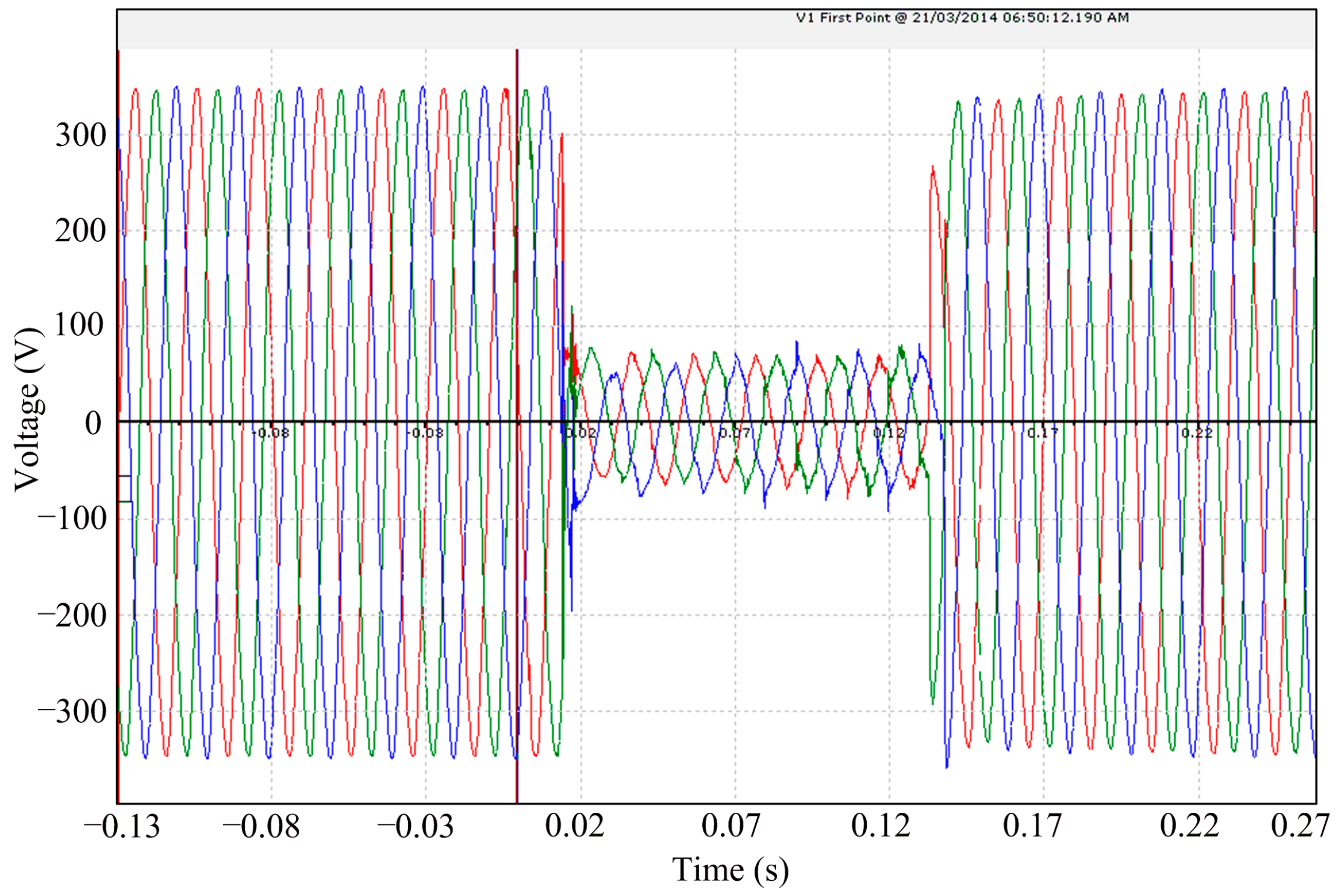
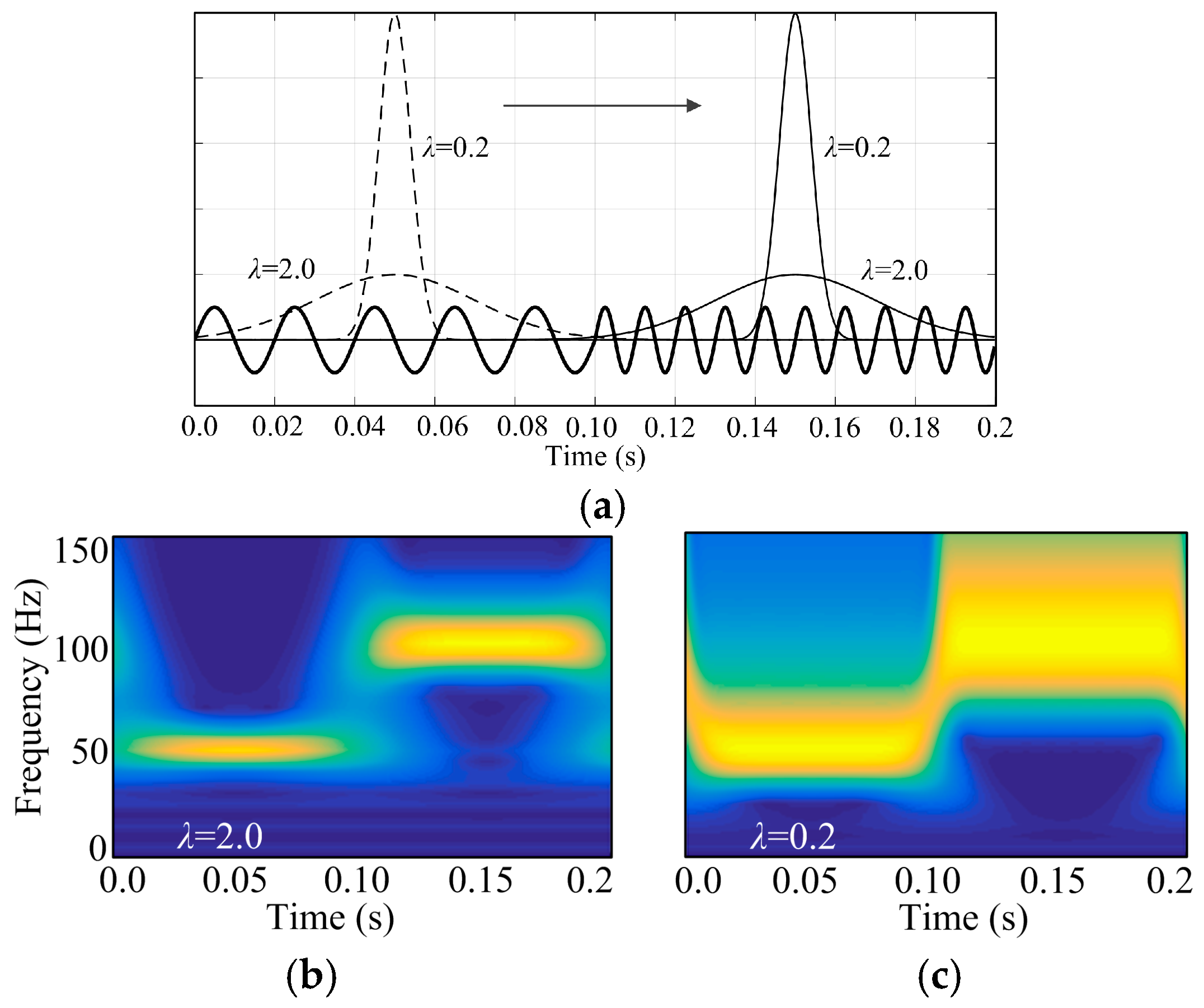
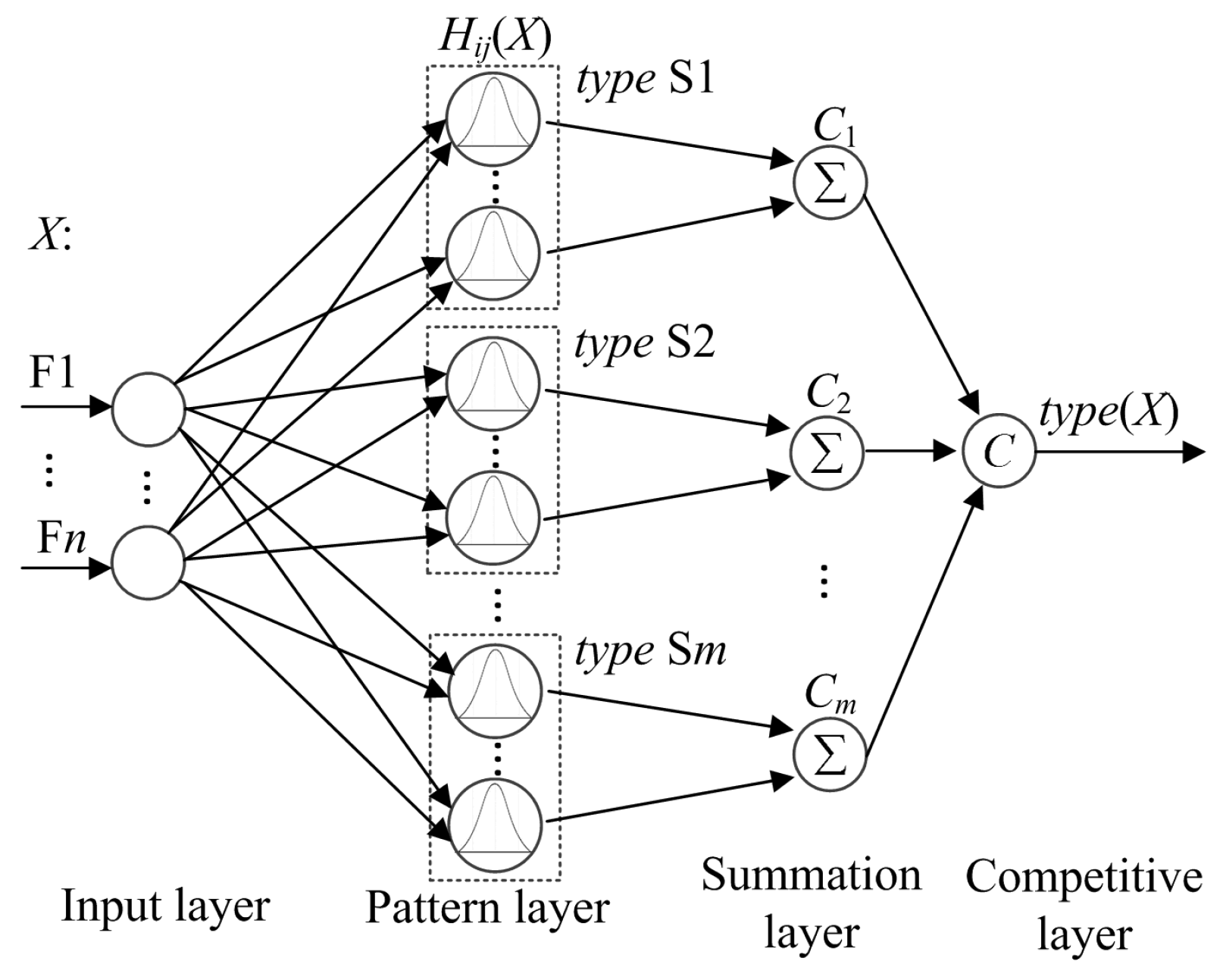

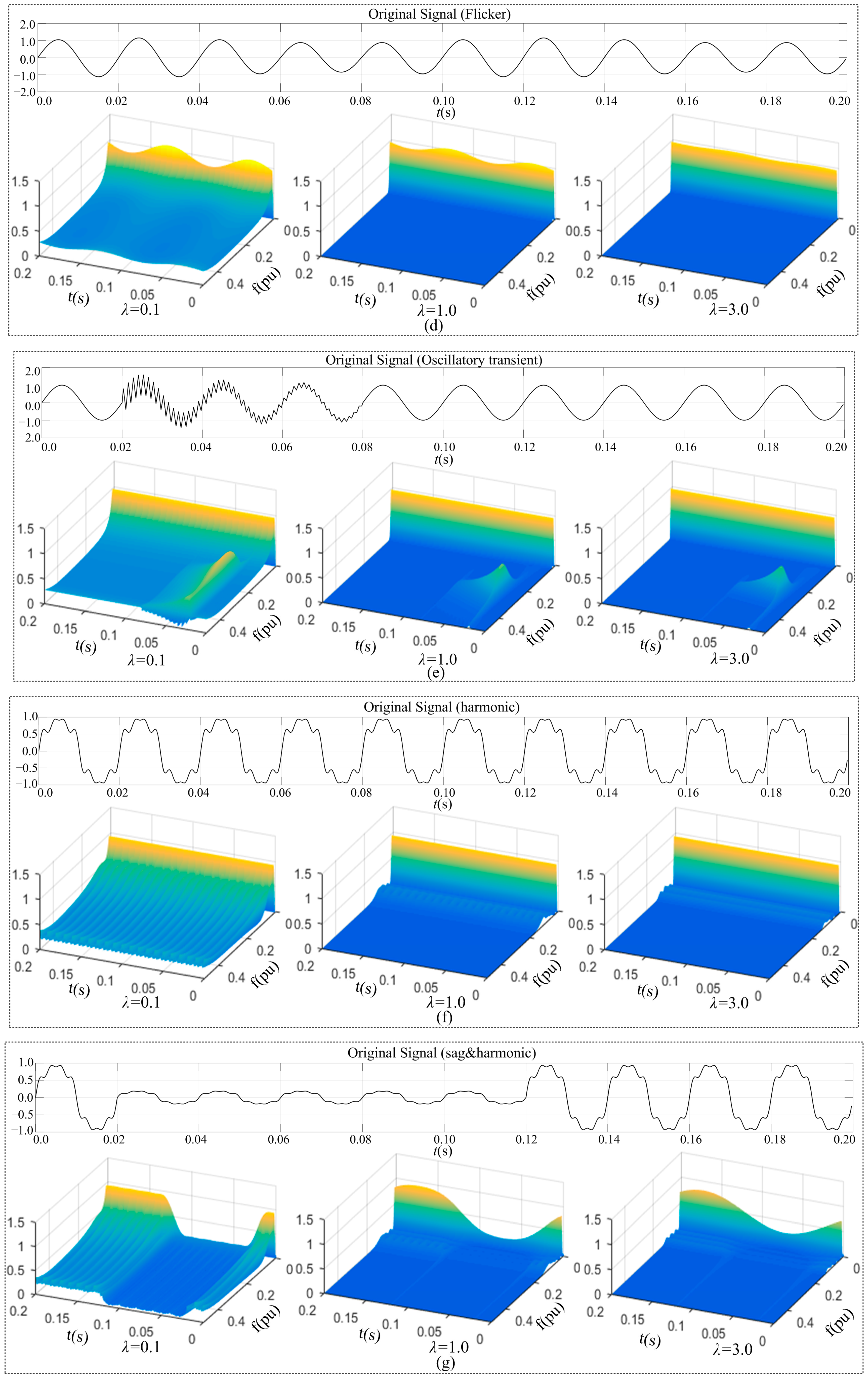
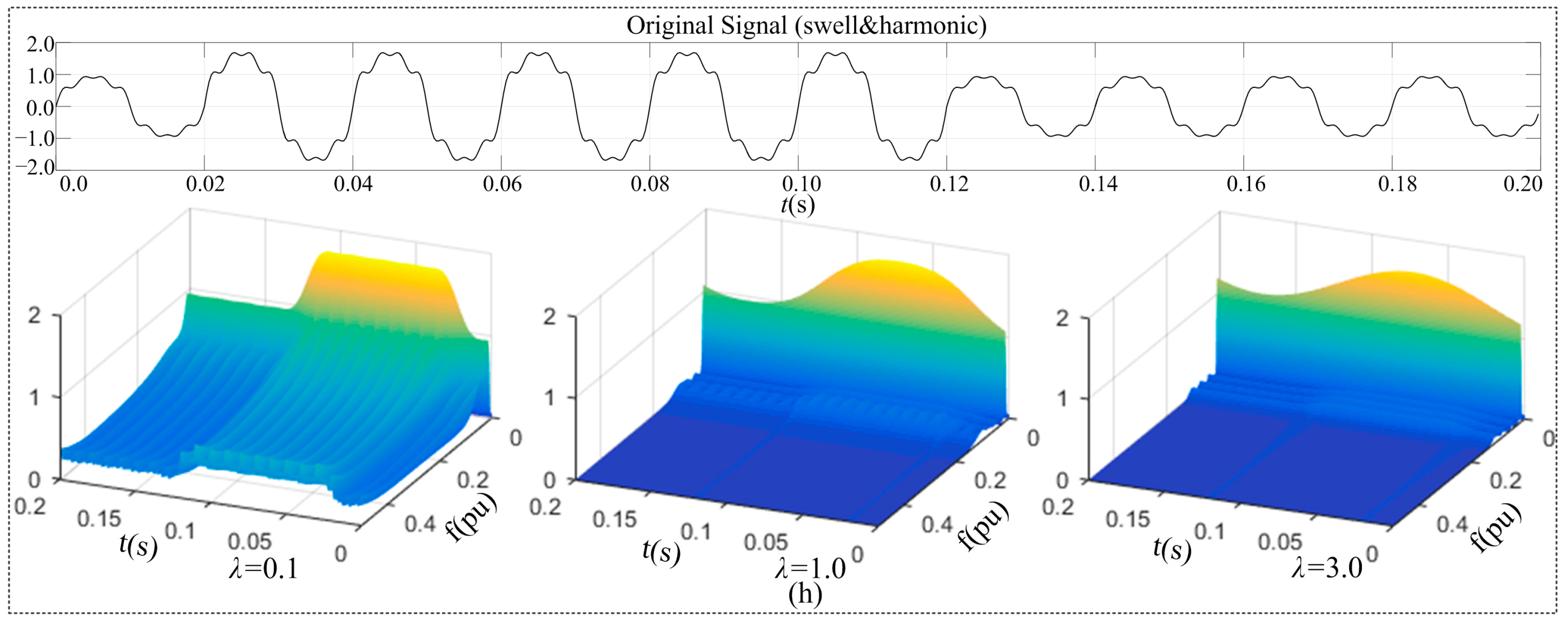

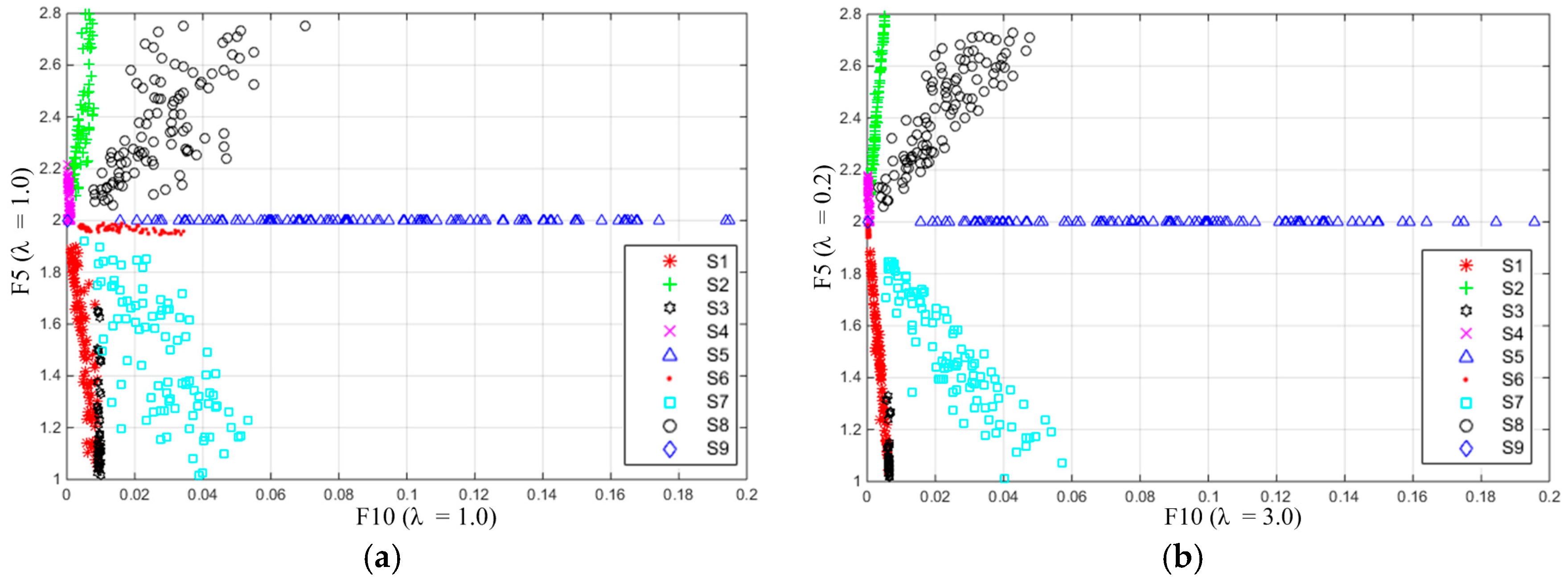
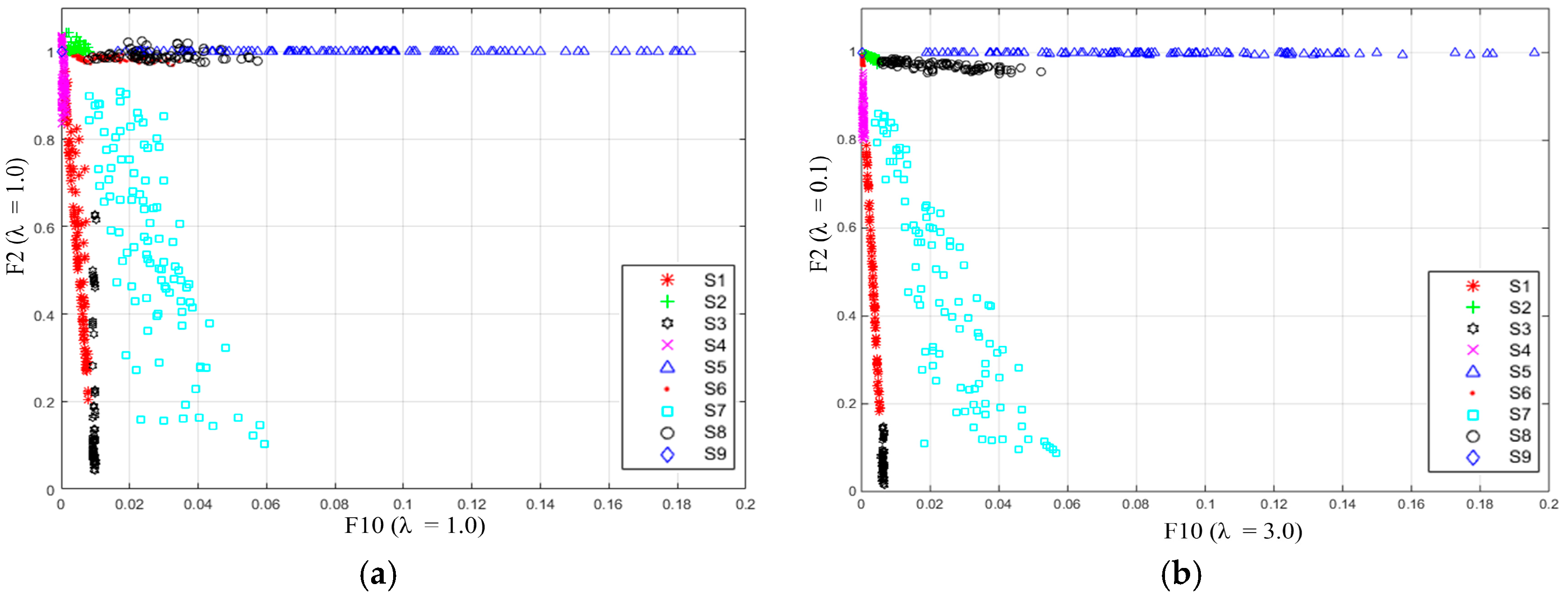


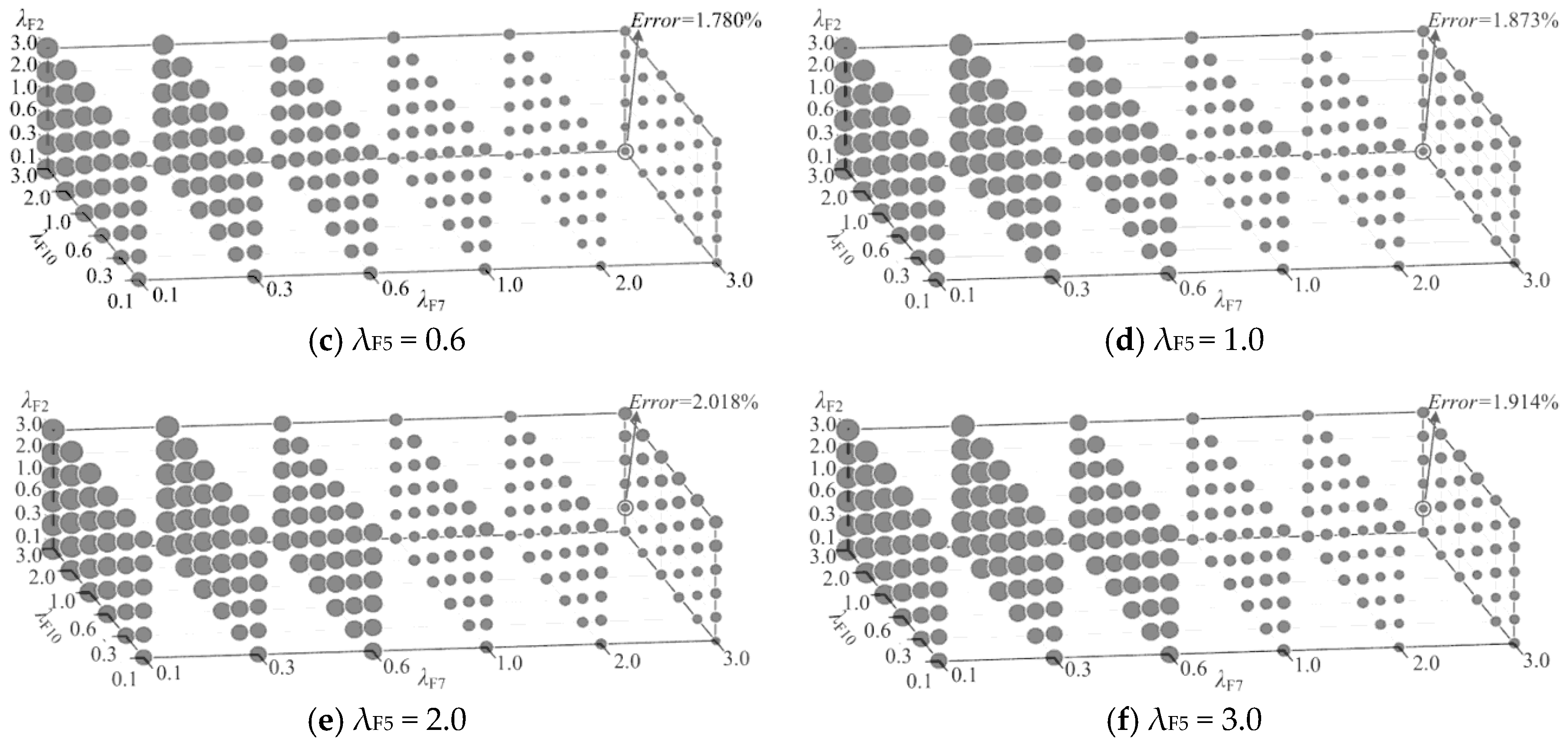
| Symbol | Type of Disturbance Signal | Equations | Parameters |
|---|---|---|---|
| S1 | Sag | ||
| S2 | Swell | ||
| S3 | Interruption | ||
| S4 | Flicker | ||
| S5 | Oscillatory transient | ||
| S6 | Harmonic | ||
| S7 | Sag and harmonic | ||
| S8 | Swell and harmonic | ||
| S9 | Normal sine | - |
| Category | S1 | S2 | S3 | S4 | S5 | S6 | S7 | S8 | S9 | Accuracy |
|---|---|---|---|---|---|---|---|---|---|---|
| S1 | 592 | 0 | 8 | 0 | 0 | 0 | 0 | 0 | 0 | 98.67% |
| S2 | 0 | 583 | 0 | 17 | 0 | 0 | 0 | 0 | 0 | 97.17% |
| S3 | 0 | 0 | 600 | 0 | 0 | 0 | 0 | 0 | 0 | 100% |
| S4 | 0 | 9 | 0 | 591 | 0 | 0 | 0 | 0 | 0 | 98.50% |
| S5 | 0 | 0 | 0 | 0 | 600 | 0 | 0 | 0 | 0 | 100% |
| S6 | 0 | 0 | 0 | 0 | 0 | 600 | 0 | 0 | 0 | 100% |
| S7 | 6 | 0 | 0 | 0 | 0 | 0 | 594 | 0 | 0 | 99.00% |
| S8 | 0 | 0 | 0 | 0 | 0 | 0 | 0 | 600 | 0 | 100% |
| S9 | 0 | 0 | 0 | 0 | 0 | 0 | 0 | 0 | 600 | 100% |
| PNN classification accuracy = 99.259% | ||||||||||
| λF2, λF5, λF7, λF10 | PNN Classification Accuracy (%) | |||
|---|---|---|---|---|
| Pure | 40 dB | 30 dB | 20 dB | |
| 0.1, 0.1, 3.0, 3.0 | 99.26 | 99.13 | 98.63 | 98.38 |
| 1.0, 1.0, 1.0, 1.0 | 96.92 | 96.78 | 96.65 | 95.94 |
| 0.1, 2.0, 3.0, 0.6 | 97.42 | 96.80 | 96.62 | 96.17 |
| 2.0, 1.0, 0.1, 1.0 | 91.40 | 91.27 | 91.00 | 90.07 |
| 3.0, 1.0, 2.0, 1.0 | 97.04 | 95.98 | 95.87 | 95.68 |
| Category | Classification Accuracy (%) | ||||
|---|---|---|---|---|---|
| Proposed Method | [4] | [8] | [16] | [17] | |
| S1 | 98.67 | 88 | 98 | 95 | 100 |
| S2 | 97.17 | 96.5 | 92 | 91 | 100 |
| S3 | 100 | 85.55 | 100 | 99 | 100 |
| S4 | 98.50 | - | 98 | 98 | 94 |
| S5 | 100 | - | 100 | 100 | 98 |
| S6 | 100 | 100 | 92 | 96 | 98 |
| S7 | 99.00 | 100 | 93 | 98 | 98 |
| S8 | 100 | 100 | 90 | 98 | 97 |
| S9 | 100 | 100 | 100 | 100 | 100 |
| Average classification accuracy | 99.26 | 95.71 | 95.5 | 97.22 | 98.33 |
© 2017 by the authors; licensee MDPI, Basel, Switzerland. This article is an open access article distributed under the terms and conditions of the Creative Commons Attribution (CC-BY) license (http://creativecommons.org/licenses/by/4.0/).
Share and Cite
Wang, H.; Wang, P.; Liu, T. Power Quality Disturbance Classification Using the S-Transform and Probabilistic Neural Network. Energies 2017, 10, 107. https://doi.org/10.3390/en10010107
Wang H, Wang P, Liu T. Power Quality Disturbance Classification Using the S-Transform and Probabilistic Neural Network. Energies. 2017; 10(1):107. https://doi.org/10.3390/en10010107
Chicago/Turabian StyleWang, Huihui, Ping Wang, and Tao Liu. 2017. "Power Quality Disturbance Classification Using the S-Transform and Probabilistic Neural Network" Energies 10, no. 1: 107. https://doi.org/10.3390/en10010107






